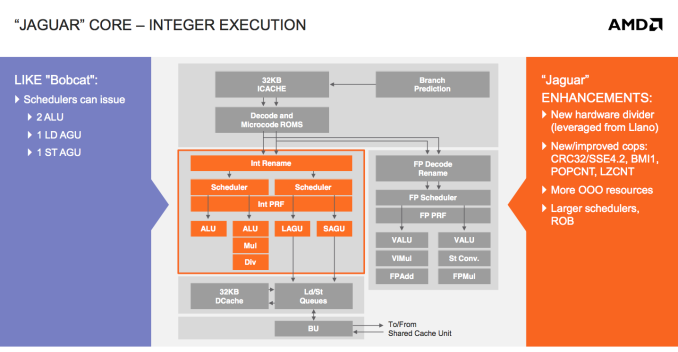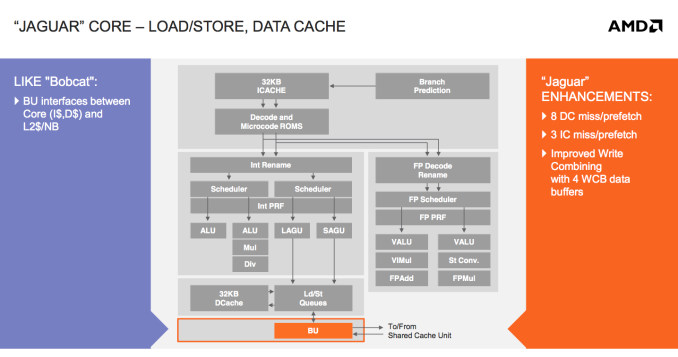AMD’s Jaguar Architecture: The CPU Powering Xbox One, PlayStation 4, Kabini & Temash
by Anand Lal Shimpi on May 23, 2013 12:00 AM ESTInteger & FP Execution
On the integer execution side, units and pipelines look largely unchanged from Bobcat. The big performance addition here is the use of Llano’s hardware divider. Bobcat had a microcoded integer divider capable of one bit per cycle, while Jaguar moves to a 2-bits-per-cycle divider. The hardware is all clock gated, so when it’s not in use there’s no power penalty.
The schedulers and re-order buffer are incrementally bigger in Jaguar. Some scheduling changes and other out of order resource increases are at work here as well.
Integer performance wasn’t a huge problem with Bobcat to begin with, but floating point performance was a different issue entirely. In our original Brazos review we found that heavily threaded FP workloads were barely faster on Bobcat than they were on Atom. A big part of that had to do with Atom’s support for Hyper Threading. AMD addressed both issues by beefing up FP execution and doubling up the maximum number of CPU cores with Jaguar (more on this later).
Bobcat’s FP execution units were 64-bits wide. Any 128-bit FP operations had to be chunked up and worked on in stages. In Jaguar, AMD moved all of its units to 128-bits wide. AVX operations complete as 2 x 128-bit operations, while all other 128-bit operations can execute without multiple passes through the pipeline. The increase in vector width is responsible for the gains in FP performance.
The move to 128-bit vectors in the FPU forced AMD to add another pipeline stage here as well. The increase in FPU size meant that some signals needed a little extra time to get from one location to the next, hence the extra stage.
Load/Store
The out-of-order load/store unit in Bobcat was the first one AMD had ever done (Bobcat beat Bulldozer to market, so it gets the claim to fame there). As such there was a good amount of room for improvement, which AMD capitalized on in Jaguar. The second gen OoO load/store unit is responsible for a good amount of the ~15% gains in IPC that AMD promises with Jaguar.














78 Comments
View All Comments
Spunjji - Friday, May 24, 2013 - link
Every CPU manufacturer does that... why would they include numbers they have no control over?araczynski - Thursday, May 23, 2013 - link
Can anyone clue me in as to how AMD got the rights to make 'PU's for both of the consoles? Was it just bang/$ vs Intel/IBM/etc? Not a fanboy of either camp (amd/intel), just curious.Despoiler - Thursday, May 23, 2013 - link
It was purely the fact that they have an APU with a high end GPU on it. Intel is nowhere near AMD in terms of top tier graphics power. Nvidia doesn't have x86. The total package price for an APU vs CPU/GPU made it impossible for an Intel/Nvidia solution to compete. The complexity is also much less on an APU system than CPU/GPU. The GPU needs a slot on the mobo. You have to cool it as well as the CPU. Less complexity = less cost.araczynski - Thursday, May 23, 2013 - link
thanks.tipoo - Thursday, May 23, 2013 - link
Multiple reasons, AMD has historically been better with console contracts than Nvidia or Intel though, those two want too much control over their own chips while AMD licences them out and lets Sony or MS do whatever with them. They're probably also cheaper, and no one else has an all in one APU solution with this much GPU grunt yet.araczynski - Thursday, May 23, 2013 - link
thanks.WaltC - Thursday, May 23, 2013 - link
Good article!--as usual, it's mainly Anand's conclusions that I find wanting...;) Nobody's "handing" AMD anything, as far as I can see. AMD is far, far ahead of Intel on the gpu front and has been for years--no accident there. AMD earned whatever position it now enjoys--and it's the only company in existence to go head-to-head with Intel and beat them, and not just "once," as Anand points out. Indeed, we can thank AMD for Core 2 and x86-64; had it been Intel's decision to make we'd all have been puttering happily away on dog-slow, ultra-expensive Itanium derivatives of one kind or another. (What a nightmare!) Intel invested billions in world-wide retool for Rdram while AMD pushed the superior market alternative, DDR Sdram. AMD won out there, too. There are many expamples of AMD's hard work, ingenuity, common sense and lack of greed besting Intel--far more than just two. It's no accident that AMD is far ahead of Intel here: as usual, AMD's been headed in one direction and Intel in another, and AMD gets there first.But I think I know what Anand means, and that's that AMD can not afford to sit on its laurels. There's nothing here to milk--AMD needs to keep the R&D pedal to the medal if the company wants to stay ahead--absolutely. Had the company done that pre-Core 2, while Intel was telling us all that we didn't "need" 64-bits on the desktop, AMD might have remained out front. The company is under completely different management now, so we can hope for the best, as always. Competition is the wheel that keeps everything turning, etc.
Sabresiberian - Thursday, May 23, 2013 - link
The point Anandtech was trying to make is that no one is stepping up to compete with AMD's Jaguar, and so they are handing that part of the business to AMD - just as AMD handed their desktop CPU business to Intel by deciding not to step up on that front. If you don't do what it takes to compete, you are "handing" the business to those who do. This is a complement to AMD and something of a slam on the other guys, not a suggestion that AMD needed some kind of charity to stay in business here.I want to suggest that you are letting a bit of fanboyism color your reaction to what others say. :)
Perhaps if AMD had been a bit more "greedy" like Intel is in your eyes, they wouldn't have come so close to crashing permanently. Whatever, it has been very good to see them get some key people back, and that inspires hope in me for the company and the competition it brings to bear. We absolutely need someone to kick Intel in the pants!
Good to see them capture the console market (the two biggest, anyway). Unfortunately, as a PC gamer that hates the fact that many games are made at console levels, I don't see the new generation catching up like they did back when the PS3 and Xbox 360 were released. It looks to me like we will still have weaker consoles to deal with - better than the previous gen, but still not up to mainstream PC standards, never mind high-end. The fact that many developers have been making full-blown PC versions from the start instead of tacking on rather weak ports a year later is more hopeful than the new console hardware, in my opinion.
blacks329 - Thursday, May 23, 2013 - link
I honestly expect the fact that both PS4 and X1 are x86 will benefit PC games quite significantly as well. Last gen devs initially developed for 360 and ported over to the PS3 and PC and later in the gen shifted to PS3 as the lead architect with some using PCs. I expect now, since porting to PS4 and X1 will be significantly easier, PC will eventually become the lead platform and will scale down accordingly for the PS4 and X1.As someone who games more on consoles than PCs, I'm really excited for both platforms as devs can spend less time tweaking on a per platform basis and spend more time elsewhere.
FearfulSPARTAN - Thursday, May 23, 2013 - link
Actually im pretty sure 90% still made the games on xbox first then ported to other platforms, however with all of them (excluding the wii u) being x86, the idea of them porting down from pc is quit possible and I didnt think about that. It would probably start to happen mid to late in the gen though.